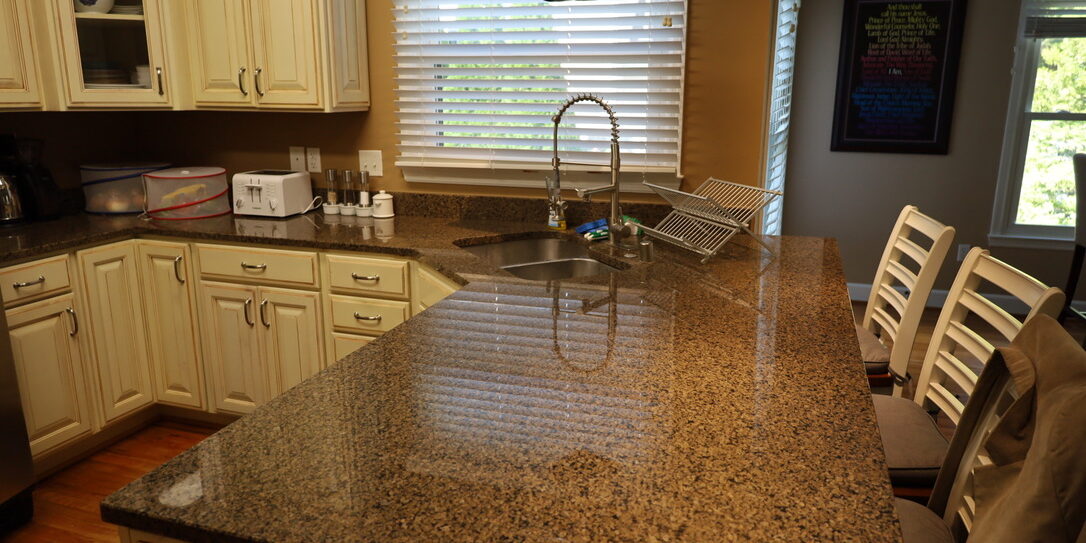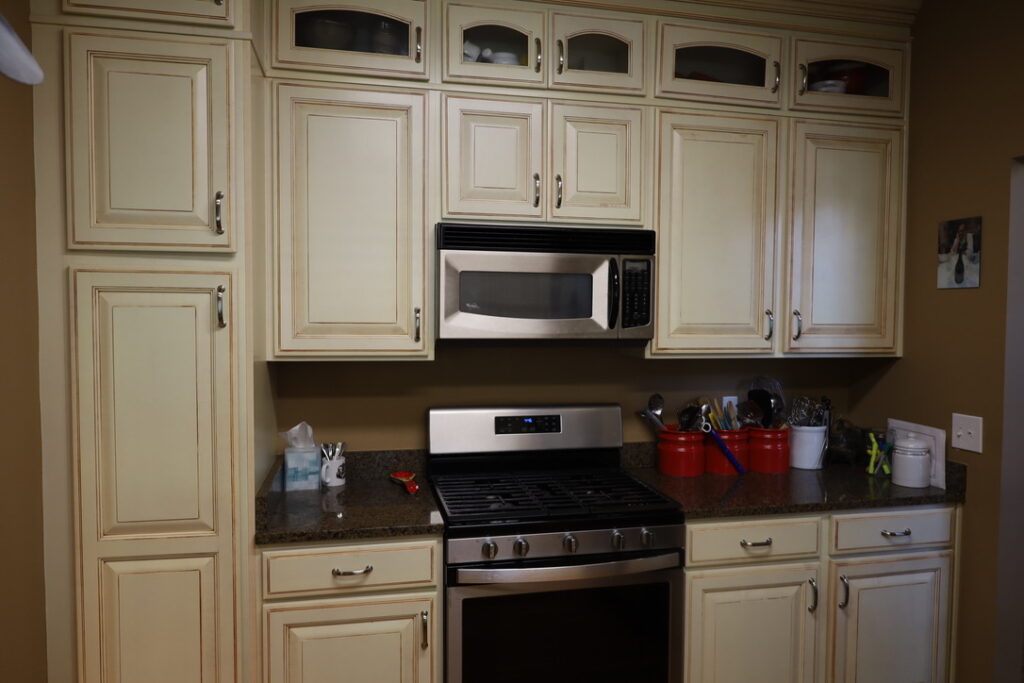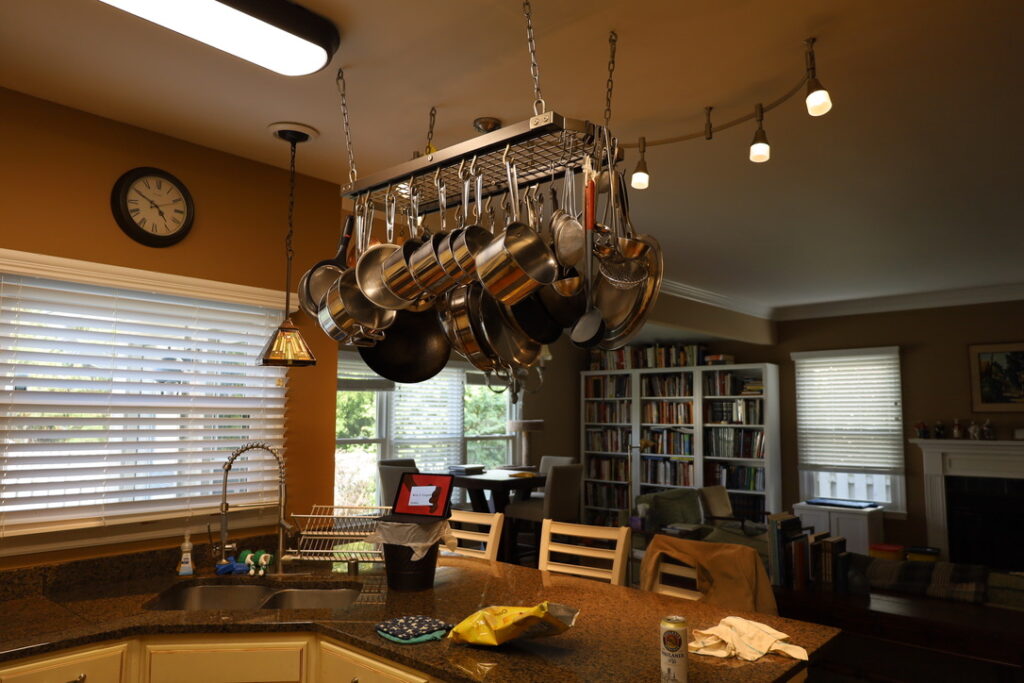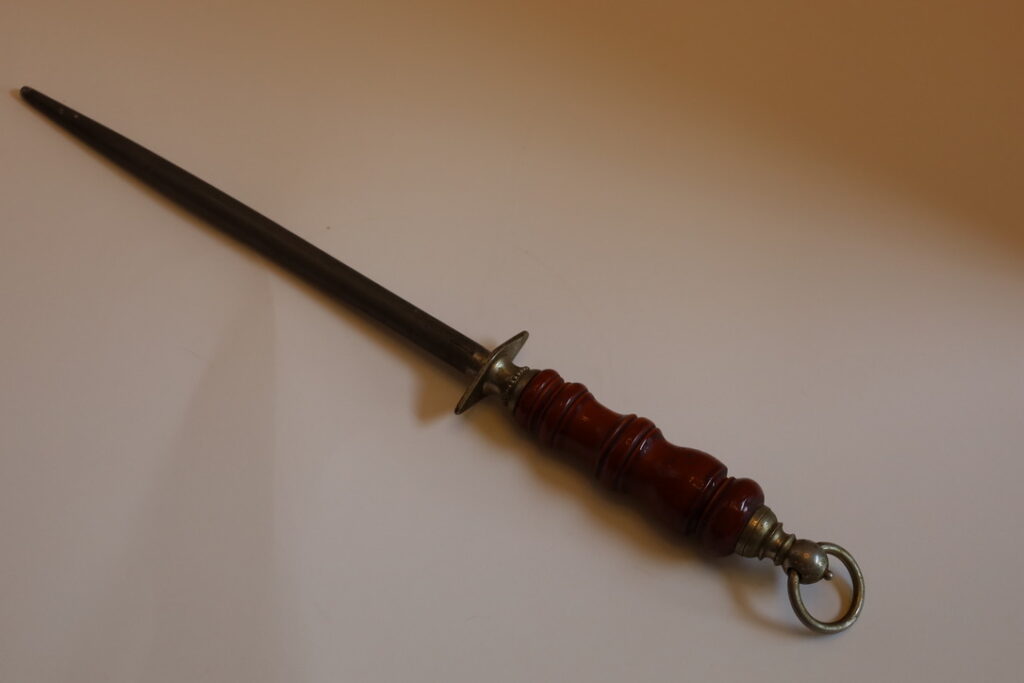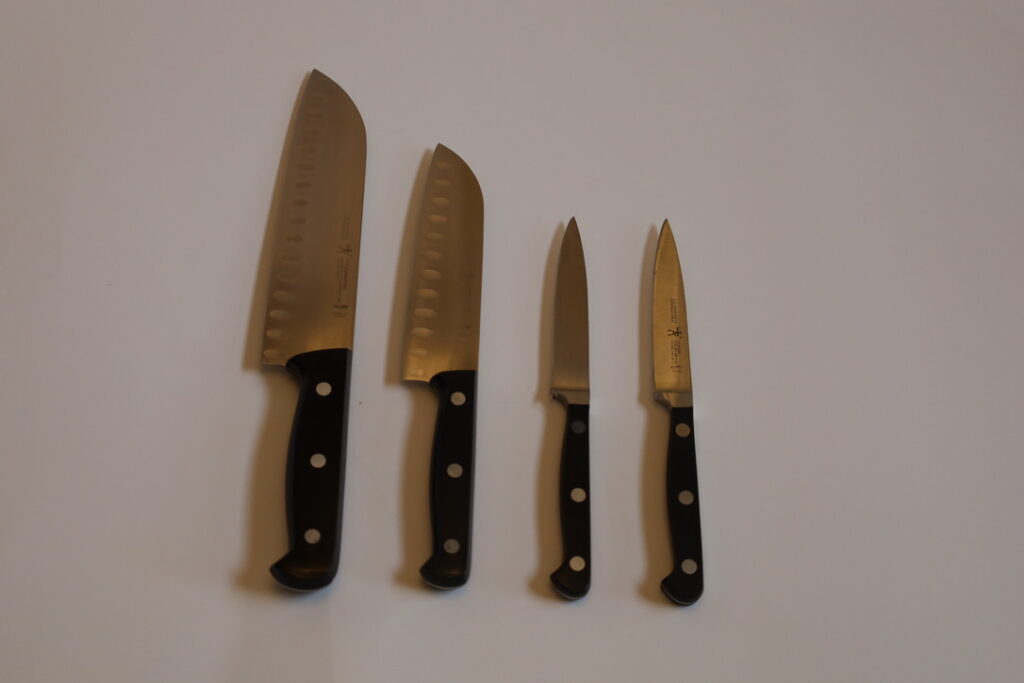The kitchen has always been a major area of fellowship in the house, a center for love, warmth and joy. However, it is also the room with the most hazards and risks. Most of these issues come from poor design, poor ergonomics, or lack of attention and planning. Shelves too high or too low, high heat from the range or oven and knives all can yield damage and injury. So how to keep the kitchen safer.
Working in the kitchen requires focus and close attention to detail. Trying to work too fast, rushing or distraction can all lead to injuries. It is always worth the little extra time to focus on the job at hand. I actually ignore friends and family when I am using knives for example and focus on the cutting. Once I put the knife down I can then engage in the discussion. Use the appropriate technique when using knives to keep your fingers and thumb away from the blade, as described in another blog on this site. Always read your recipes and understand the steps. Make sure you have all your ingredients and practice mis en place. This prevents the panic and rush when you realize that you don’t have an ingredient or have misunderstood the recipe.
Keeping floors and counters clean is important. And when cooking there are always sort periods of time during which dishes can be cleared and washed and counters cleaned. A cluttered work space can yield injuries when moving hot pans or water for example. Water frequently ends up on the floor, which could be a potential cause of slips and falls. When this happens wipe up the water as soon as possible. Grease on the floor is another obvious risk for falls. Grease on the floor should be cleaned up immediately. Keeping the floor dry and clean can help prevent slip and fall accidents.
Standing for hours cooking can cause strain injuries, such as plantar fasciitis. Placing think anti-fatigue and non-slip mats under areas in the kitchen where you spend the most time standing is one way to help improve kitchen safety. These can also help with water spills. I use 2 thick mats in my kitchen.
Perhaps the risk of fire in the kitchen is of the most concern. Firstly, be observant, and cook without distractions. This is not always easy; phone calls and other things can distract you from the range and stove which could quickly yield a fire. Never leave things cooking on the stove and walk out of the room. You can always turn off the burner, do what you have to do, and come back and turn the burner back on. Always keep a fire extinguisher close at hand to the kitchen and know its location. Fire alarms near the range and oven are also necessary for safety. Check them regularly to make sure they work. Know where the household breaker box is, keep it uncluttered for easy access. If there is a microwave or electrical fire for example, throwing the breaker can reduce further spread. But focus on putting out the fire before you run to the breaker box. Fires spread very quickly so stay focused and get the fire out as soon as possible. Water on a grease fire will spread the fire. Keep a box of baking soda close at hand since it can be poured over a fire either water or grease. However, if you have a fire extinguisher this should be your first approach to any fire in the kitchen, grease or water. Don’t waste time looking for baking soda, get the extinguisher. Deep frying can be a significant risk, see our blog on deep frying. You need to know what the temperature of the oil is, to make sure it isn’t too high and close to the flash point. A thermometer and monitoring the temperature continuously are very important. Place a deep fry thermometer attached to the side of the pot. When you do deep frying use a deep pot, which helps prevent and reduce splatter and also helps keep the oil temperature more stable at 350-375 degrees F. As mentioned, always know the fire extinguishers location and also pan tops as a first step to smother a fire. Do not ware clothing with loose cloth that could end up in the burner on the range, or in the fry pan. A apron is a further barrier to hot water and other things, it also keeps clothing close to the body and not loose.
Steam is very dangerous, perhaps even more so than open flames. Care should always be taken when steaming food, or when opening containers that have the potential for releasing steam. Burns can occur quickly, so care should always be taken. Interestingly microwaves are responsible for more scalding injuries from steam than any other kitchen appliance. Always be careful when removing containers from the microwave, or when opening these containers. Always touch quickly to see how hot the containers or plates are before grabbing them with your hands. Use over mitts or kitchen towels. One final note on microwaves. They frequently are at head level. An open microwave door can give a very substantial head trauma. So open the door and use two hands to remove an item, but then make sure your next step is to close the door to prevent these head injuries.
When removing pans from the oven, especially saucepans or sauté pans, be especially careful. We are used to just grabbing the handles of these pans without thought, but when removed from the oven, a loss of focus could cause one to grab the handle resulting in a serious burn. I place a potholder on the handle of a hot pan once I take them out of the oven, which reminds me it is hot. For cast iron you can purchase rubber handle covers that will indicate a hot handle. When carrying hot pots or pans, first observe the path to where the pot will be placed and make sure that that location is cleared of other obstacles. Then make sure no one else is under foot for example children or cats. Carry the pot carefully and with focus to its location. When cooking move handles of pots and pans away from the front of the stove where you can knock into them as you work. Watch where the handle is and don’t allow it to lie over a burner on the range.
Bacteria thrive in the kitchen for obvious reasons. It is important to keep kitchen sponges, cleaning brushes and cotton towels regularly cleaned. Sponges and brushes can be washed on the top shelf of the dishwasher. I wash mine frequently. Replace them as they wear out, obviously. Also rinse the sponges out thoroughly and squeeze them as dry as possible at the end of the day. This has been shown to reduce bacterial counts in these sponges. Kitchen towels should not be kept in use more than a day. Wash them in the washing machine with bleach and hot water.
Good lightening is critical for cooking and safety. Under the counter lights are well worth the cost. A dark kitchen can yield injuries. Reaching high places always presents a risk of falls. Use good quality step stools, with non-slip feet when reaching higher cabinets. Obviously don’t have loose cords hanging over the range or oven, or the sink. Don’t have loose cords on the floor where you get tangled in them and trip.
A very sharp knife will reduce the number of cuts in the kitchen. A very sharp knife will require less pressure to cut through vegetables and other ingredients. However, when a cut occurs it can be worse, since a sharper knife can cut deeper. Keeping ones knives clean and sharp is obviously critical. Do not submerge the knife or place it in the dishwasher. If you have your knives in a knife block, so much the better, but do not put them loose in a drawer, you are just asking for a cut. I dislike the magnetic knife holders, since they magnetize the knife. I use the NIUXX bamboo in drawer knife holder, they work well and keep all the knives separate and safe. But obviously this depends on kitchen space, resources and what works best for you.
Try not to handle knives when your hands are wet, and especially when greasy. Take the few seconds to wash them, then use the knife.
Washing your hands frequently is a very good idea. Keep a pump soap dispenser close to the sink and use it. Don’t let foods sit out, as soon as you use an ingredient place it back into the refrigerator. Marinate and thaw foods in the refrigerator. Obviously thawing foods when you are working in the kitchen would be OK since you can consistently monitor. Planning ahead, you can put frozen food into the refrigerator the evening before it is to be cooked.
When working with raw chicken, fish and meat, there is the potential for staphylococcus and e coli. Don’t wash meat, chicken or fish, and I say this with a caveat. Frequently when these are thawed after freezing, juices can accumulate, that I feel should be washed away. The problem with washing has to do with the splashing of meat, chicken and other juices over the sink and counter tops, which spreads contamination of bad bacteria. With deeper sinks and care, however you can wash these things without splashing. But this requires preparation. Clean the counters, remove utensils, containers and anything else that could become contaminated and is near. Place the meat, chicken or fish in the sink in a colander and gently wash away the juices you want to discard. Take the meat, place in paper towels that you have already placed near the sink on a plate and dry it off, discard the paper towels carefully and place the plate in the dishwasher. Then place the meat in a container for further work and clean the sink and surrounding countertop with kitchen antibacterial spray.
These things can become second nature as you practice them and adhere to them. But in the beginning consider making a list of the things above and place that list in a place where you can routinely review, see below. Safety in the kitchen makes cooking more enjoyable.
Check Safety in the Kitchen
1. Pay Attention and focus. Avoid distractions and do not “multitask”, focus on the task at hand. We are not chefs, but rather home cooks, there is a difference.
2. Be slower and deliberate. Do not rush in the Kitchen.
3. Read the recipe, make sure of the ingredients and steps necessary.
4 Learn appropriate knife skills
5. Keep floors free of spills.
6. Keep counters uncluttered and clean.
7. Consider fatigue and slip reducing mats in high use areas.
8. Know the location of the fire extinguisher and keep it close and accessible to the kitchen.
9. Baking soda and pan lids can quickly put out a fire, know their location.
10. Deep fry carefully with thermometers, deep pots and close attention.
11. Never have a pan on the range and leave the kitchen.
12. Steam is dangerous, be careful when removing items from the microwave and when steaming food.
13. Keep pan handles away from the front of the stove or open flame.
14. Make sure when removing pans from the oven you have a cleared place to put them.
15. Clean sponges and brushes in the dishwasher frequently.
16. Rinse and squeeze out sponges every evening, set aside to dry overnight.
17. Provide lots of good soft lightening in the kitchen.
18. Keep knives sharp and clean. Store them appropriately.
19. Wash hands regularly.
20. Use great care when preparing raw meat, chicken or fish.


